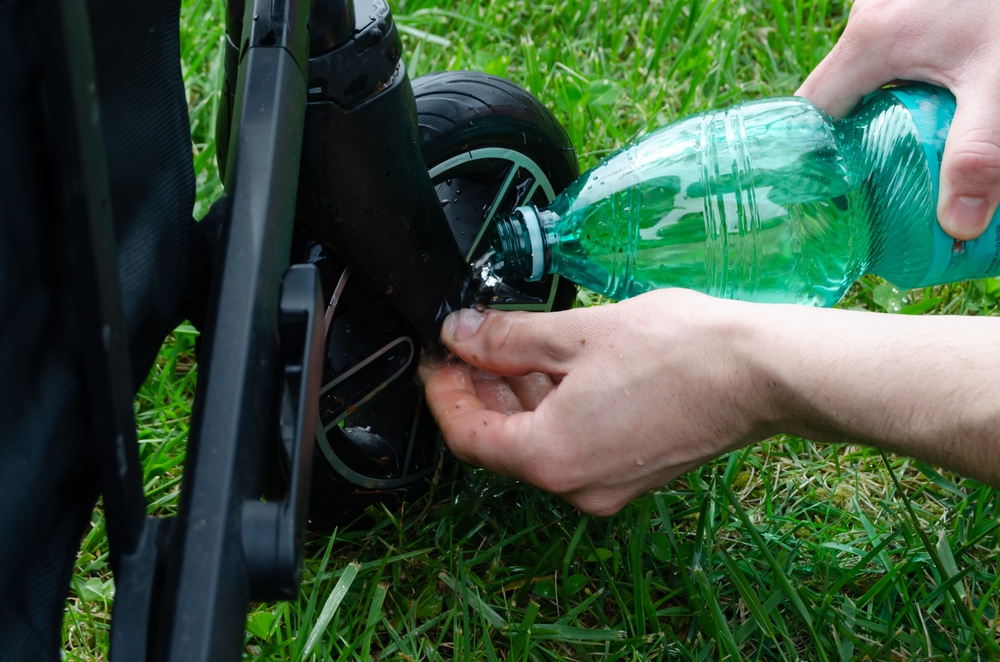Taking proper care of your pushchair will not only extend its longevity but will ensure that it’s safe for your little cherub. But, we understand that parents are busy people who don’t have time to spend hours a week cleaning and maintaining their pushchair, which is why we have put together a guide to pushchair maintenance, with handy tips and tricks to look after your pushchair properly yet efficiently.
Wheel maintenance
The wheels on a pushchair take some serious force day in, day out so they shouldn’t be neglected. Without proper care and attention, the wheels can become damaged, squeaky, loose and wrapped in dirt and debris which will impact the use and safety of the overall pushchair.
One of the best and quickest things you can do to maintain your pushchair’s wheels is to give them a regular clean every few days or after a muddy walk. If you’re unsure of how to clean the wheels, we have more information on this below. Also, make sure you give the wheels a deep clean every so often to remove any stubborn dirt and debris in hard-to-reach places as this can build up over time.
Lubrication is important for the smooth turning of your pushchair’s wheels so make sure you use a silicone-based lubricant on the wheels, axle and bearing to keep it rolling like the first day you got it. It’s a good idea to do this often so a great time to do it would be when you give your wheels a thorough clean.
Look for signs of wear and tear
Inspect the wheels regularly for damage and if you notice any issues, make sure you replace them as soon as possible as damaged wheels can make the pushchair difficult to push, wobbly and unsafe. Look out for things like cracks, excessive tread wear, punctures, flat spots and any other signs of wear and tear.
Depending on the model of the pushchair, you may have inflated wheels which means you need to maintain the tyre pressure recommended by the manufacturer. Some pushchair wheels are made out of foam and therefore don’t need to be inflated or the pressure checked. In addition to this, check the wheel alignment to make sure they are straight and facing forward and if they aren’t, consult the manufacturer’s instructions.
Regular cleaning
Keeping your pram fresh and clean isn’t just to keep it looking new and comfortable for your little one but it extends the life of your pushchair and ensures it is safe to use. Here are some of our top tips for cleaning your pushchair.
Cleaning the wheels
As mentioned above, do a quick surface clean every few days and a thorough clean every so often. When doing a quick clean, use a warm cloth with soapy water to remove any loose bits of dirt and debris.
For a thorough, deep clean, use a soft bristle brush with warm, soapy water which will allow you to get into the small, hard-to-reach spaces in your wheels. Pay extra attention to the axles and hubs as dirt can accumulate and impact the performance. You will need some paper towels or soft towels to dry the wheels afterwards.
If you can detach the wheels, this will allow for an even deeper clean so you can get to all the different areas of the wheel. However, always check the manufacturer’s guide before doing this as not all pushchair wheels can easily be removed. Check to make sure the instructions show you how to remove and attach the wheels to the pram before taking them off.
Cleaning the fabric
Always check the labels and the instructions before cleaning the fabric of your pushchair as some fabrics aren’t suitable for the washing machine, making them hand wash only. Most pushchair fabrics are fine to go into the washing machine and this includes shoulder pads and accessories such as footmuffs etc.
If the manufacturer’s instructions say it is safe to put the removable fabric in the washing machine, it’s best to use a gentle detergent and wash on a cold cycle so you don’t damage the fabric or the colour. For other fabric parts, like the canopy or sunshade, these aren’t usually machine washable so gentle handwash is the best option.
To hand wash fabrics on your pushchair, remove them if possible by following the instructions. Use warm water with a clean cloth or sponge and gently wipe down. We advise not to tumble dry any pushchair fabrics and to allow them to air dry completely, out of direct sunlight, before putting the fabrics back on and using them.
If your little one likes to have a snack in their pram or climbs into it with muddy shoes after a day of fun, then you might notice stains on the fabric. If this is the case, don’t wash the fabric straight away but use a stain remover treatment first, as this will help to remove the stubborn stain.
Cleaning the chassis
Cleaning the chassis is quick and easy as all it requires is a soft cloth and warm, soapy water. Don’t use any harsh brushes or sponges on the chassis as this can cause scratches and remove the paint. Towel dry or allow to air dry before before using.
When cleaning the chassis, check for signs of wear and tear such as squeaking at the joints. Try using a silicone-based lubricant to keep the chassis nimble and moving smoothly.
Pushchair upkeep
One of the most important things to consider is to make sure you choose a pram that is fit for purpose. For example, if you intend to use your pram on tricky terrain make sure you choose a pushchair that is suitable for this. Always use your pushchair as per the manufacturer’s instructions to avoid unintentional damage.
As well as regular cleaning, lubrication and damage inspection there are a few other things you can do to keep your pushchair safe and make it feel like new for as long as possible. Regularly inspect the parts that you may forget about such as the harness and straps. Make sure they are in good condition so they keep your baby safe and comfortable.
If your pram is collapsable, check the folding mechanism is running smoothly and locks in place as it should to keep it safe. If there is a problem with this, consult the manufacturer’s handbook or instructions. In addition to this, make sure the pram’s suspension is intake otherwise this could put extra pressure on the wheels and chassis.
Finally, never exceed the weight limit of your pushchair and that includes the weight of your child and the basket. Putting too much weight such as shopping, or essentials for a family day out in the pram’s basket will put too much pressure on your pushchair and could cause it to break or become loose.
Pushchair maintenance for longevity and safety
It shouldn’t take too much time and effort to properly maintain your pram. Just a few minutes a week will ensure the pushchair is safe and comfortable for your mini-passenger and will make sure it lasts as long as you need it to.
The main things to remember are to always read the user manual on care and maintenance instructions, clean your pushchair regularly (including the fabric, wheels, chassis and other parts like the straps and sunshade), inspect your pushchair for signs of damage and wear and tear and choose a pram that is built for what you need it to do, such as tackle tough terrain.
When you’re not using your pushchair, make sure it is tucked away in a safe place, away from direct sunlight in a cool, dry place. Leaving a pushchair for a long time in damp places such as sheds or even lofts can cause mould to grow on your pram and this can be difficult to remove so proper storage is important.



